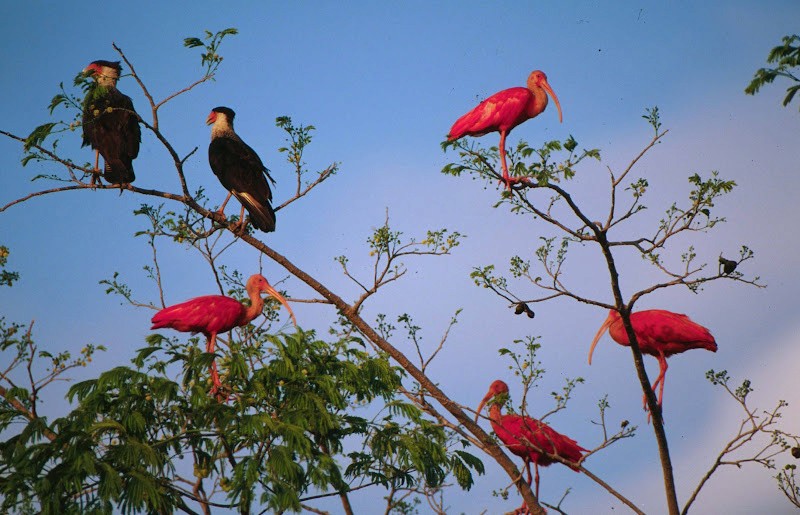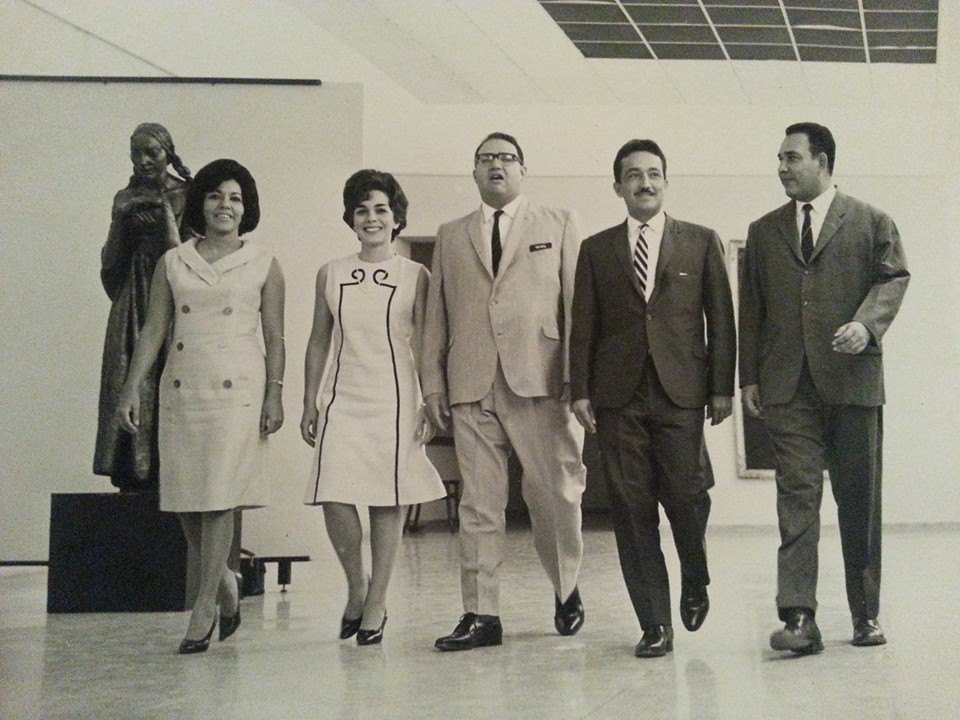Quinteto Contrapunto
Quinteto Contrapunto
Quinteto Contrapunto
March 1, 2022
March 1, 2022
From "Pinturitas del paisaje" to "Corrido de los Pájaros" - A first-hand account
By: Nota Marcata
By: Nota Marcata


This writing is a quote extracted from the book "Coplero que canta y toca" (A biography of Alberto Arvelo Torrealba) written by his daughter, Mariela Arvelo. She tells us in the first person how the lyrics of this old popular melody came about.
PINTURITAS DEL PAISAJE (LITTLE PAINTINGS OF THE LANDSCAPE)
(Lyrics of an old joropo from Barinas)
I wish to make special mention of this composition, whose music is incredibly ancient, and whose lyrics are by my father. This joropo has been interpreted by different musical groups -among them the Quinteto Contrapunto- under the title of "Corrío de los Pájaros" (Song of the birds.)
"Paintings of the landscape" is a dearly beloved poem, as I was present, very close to my father, when he wrote the verses. But I correct myself: he did not write the verses; he only dictated them while singing and driving the car, on one of the many trips we took, from Caracas to Acarigua, between August and December 1956, after my return from Italy.
That time, dad and mom were in the front seat, and I was in the back, right next to my cousins Rosita and Ninina, our two guests for the weekend trip. The three young women liked to sing, and dad would ask us for songs he wanted to hear on the way: llanero corridos, boleros from Los Panchos, and tangos by Gardel... My mother, who had a beautiful voice, would also join the group, and sometimes dad would get excited and sing with us one of his favorite ballads. The car seemed like a walking gramophone!
Suddenly, as we passed through Turmero, dad asked us:
– Girls, do you want to learn the "Corrido de los pájaros"?
– Yes!! - we answered
- Well, write it down!, because right now I'm going to make it up... Here goes the first verse, sung to the music of an old joropo!
Mom handed me a pencil and a notepad, and I began to quickly copy, while he sang and dictated at the same time:
“La paloma, pobrecita, la mató el gavilán
cuando estaba en los copitos del caujaro:
yo lo vi cuando pasó para el entierro
con su luto y su querella el taro-taro.”
"The dove, poor thing, was killed by the hawk
when it was in the little tufts of the caujaro:
I saw it when it passed for the burial
with its mourning and its complaint the taro-taro".
He repeated it a couple of times to give me time to copy... And then he ordered:
– Now you sing it!
We sang over and over until dad said, satisfied:
- Very good! You now know the first one. Now I have to think of the second verse...
Mom and we stayed silent, so he could concentrate... Not even half an hour had passed when he spoke to us, very excited:
- Ready, young ladies! Write down the second one!...
He started to sing, and my cousins and I began to write:
Las chenchenas del Masparro tienen un parrandón
que se escucha llano arriba y llano abajo:
yo lo vi cuando pasó para la fiesta
de amarillo y paltó negro el arrendajo.”
"The chenchenas of Masparro have a great party
that is heard flat above and flat below:
I saw it when it passed for the party
in yellow and black paltó the magpie".
We continued our cheerful and musical journey to Acarigua: Every few kilometers a new verse for the old joropo from Barinas.
We had already noted and learned five verses when we stopped at a little roadside restaurant to have lunch. It was very hot when we resumed our route to Acarigua, and for a while my cousins and I remained silent, wishing to sleep and having little enthusiasm to continue singing...
The afternoon was refreshing when dad called our attention:
- It's time to wake up, young ladies! We are about to arrive in Acarigua and we still need the last verse. Write quickly, before the idea slips away!
And we duly fulfilled our final task: We were stopping in front of grandma's house when we copied and sang the last verse of the song:
Allá vienen la camata, el tucán y el paují
apostando a quien más grita y quien más vuela:
Yo los vide, pinturitas del paisaje
sobre el verde corazón de Venezuela”(1)
"Here come the camata, the toucan and the paují
betting on who screams the most and who flies the most:
I saw them, paintings of the landscape
over the green heart of Venezuela"(1)
(1) Arvelo Torrealba, Alberto - "Poetic Works" pp.236-237
Arvelo, Mariela - "Coplero que canta y toca" pp. 486-488
This writing is a quote extracted from the book "Coplero que canta y toca" (A biography of Alberto Arvelo Torrealba) written by his daughter, Mariela Arvelo. She tells us in the first person how the lyrics of this old popular melody came about.
PINTURITAS DEL PAISAJE (LITTLE PAINTINGS OF THE LANDSCAPE)
(Lyrics of an old joropo from Barinas)
I wish to make special mention of this composition, whose music is incredibly ancient, and whose lyrics are by my father. This joropo has been interpreted by different musical groups -among them the Quinteto Contrapunto- under the title of "Corrío de los Pájaros" (Song of the birds.)
"Paintings of the landscape" is a dearly beloved poem, as I was present, very close to my father, when he wrote the verses. But I correct myself: he did not write the verses; he only dictated them while singing and driving the car, on one of the many trips we took, from Caracas to Acarigua, between August and December 1956, after my return from Italy.
That time, dad and mom were in the front seat, and I was in the back, right next to my cousins Rosita and Ninina, our two guests for the weekend trip. The three young women liked to sing, and dad would ask us for songs he wanted to hear on the way: llanero corridos, boleros from Los Panchos, and tangos by Gardel... My mother, who had a beautiful voice, would also join the group, and sometimes dad would get excited and sing with us one of his favorite ballads. The car seemed like a walking gramophone!
Suddenly, as we passed through Turmero, dad asked us:
– Girls, do you want to learn the "Corrido de los pájaros"?
– Yes!! - we answered
- Well, write it down!, because right now I'm going to make it up... Here goes the first verse, sung to the music of an old joropo!
Mom handed me a pencil and a notepad, and I began to quickly copy, while he sang and dictated at the same time:
“La paloma, pobrecita, la mató el gavilán
cuando estaba en los copitos del caujaro:
yo lo vi cuando pasó para el entierro
con su luto y su querella el taro-taro.”
"The dove, poor thing, was killed by the hawk
when it was in the little tufts of the caujaro:
I saw it when it passed for the burial
with its mourning and its complaint the taro-taro".
He repeated it a couple of times to give me time to copy... And then he ordered:
– Now you sing it!
We sang over and over until dad said, satisfied:
- Very good! You now know the first one. Now I have to think of the second verse...
Mom and we stayed silent, so he could concentrate... Not even half an hour had passed when he spoke to us, very excited:
- Ready, young ladies! Write down the second one!...
He started to sing, and my cousins and I began to write:
Las chenchenas del Masparro tienen un parrandón
que se escucha llano arriba y llano abajo:
yo lo vi cuando pasó para la fiesta
de amarillo y paltó negro el arrendajo.”
"The chenchenas of Masparro have a great party
that is heard flat above and flat below:
I saw it when it passed for the party
in yellow and black paltó the magpie".
We continued our cheerful and musical journey to Acarigua: Every few kilometers a new verse for the old joropo from Barinas.
We had already noted and learned five verses when we stopped at a little roadside restaurant to have lunch. It was very hot when we resumed our route to Acarigua, and for a while my cousins and I remained silent, wishing to sleep and having little enthusiasm to continue singing...
The afternoon was refreshing when dad called our attention:
- It's time to wake up, young ladies! We are about to arrive in Acarigua and we still need the last verse. Write quickly, before the idea slips away!
And we duly fulfilled our final task: We were stopping in front of grandma's house when we copied and sang the last verse of the song:
Allá vienen la camata, el tucán y el paují
apostando a quien más grita y quien más vuela:
Yo los vide, pinturitas del paisaje
sobre el verde corazón de Venezuela”(1)
"Here come the camata, the toucan and the paují
betting on who screams the most and who flies the most:
I saw them, paintings of the landscape
over the green heart of Venezuela"(1)
(1) Arvelo Torrealba, Alberto - "Poetic Works" pp.236-237
Arvelo, Mariela - "Coplero que canta y toca" pp. 486-488
Copyright ©
2021 -
2025
Nota Marcata.
All rights reserved.
Copyright ©
2021 -
2025
Nota Marcata.
All rights reserved.
Copyright ©
2021 -
2025
Nota Marcata.
All rights reserved.
